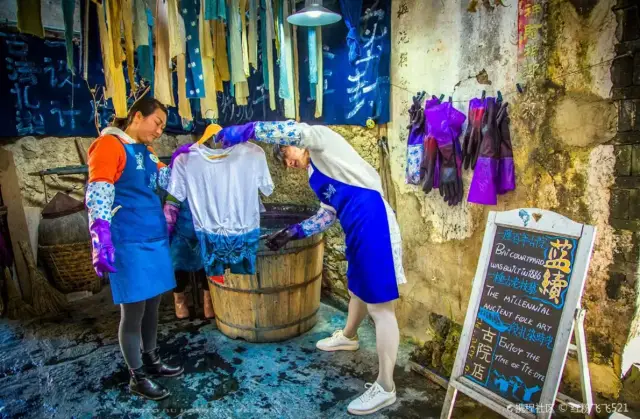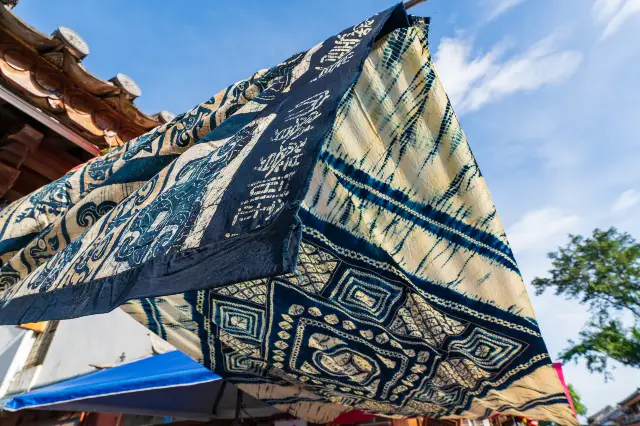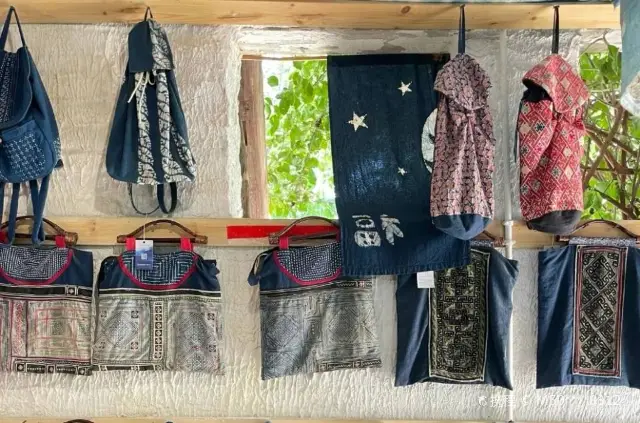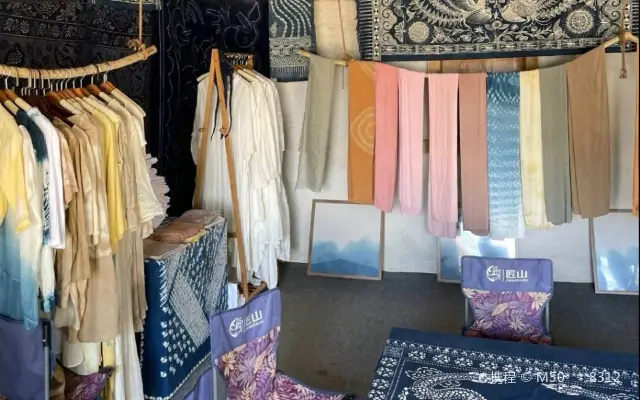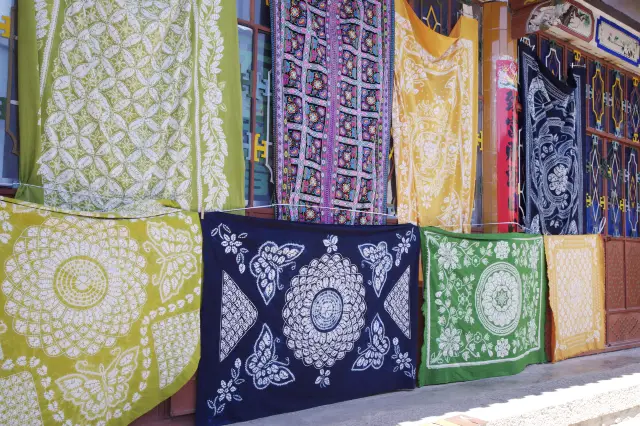2025Tie-dye Experiences in Dali|trip.com

Introduction Tie-dye Experiences in Dali
IntroductionDali tie-dyeing experience allows you to make a unique blue and white artwork by yourself and feel the unique charm of the Bai ethnic group's thousand-year intangible cultural heritage.
Raw material advantages and cultural experience: Dali is the main settlement of the Bai ethnic group. The tie-dyeing technique is an intangible cultural heritage passed down by the Bai people for thousands of years, with strong ethnic characteristics and cultural heritage. The dyes used in Dali tie-dyeing mainly come from local natural plants, such as Isatis indigotica, Polygonum tinctorium, and Artemisia argyi grown on Cangshan Mountain.

Course content and duration: The course content is rich, including explanations of the history and culture of tie-dyeing, demonstrations of the production process, teaching of basic needlework and tie-dyeing, and guidance on dyeing techniques.The production process covers drawing, template making, printing, tie-dyeing, desizing, dyeing, flower removal, rinsing, drying and ironing. The course usually lasts from half a day to a day, giving participants ample time to learn and practice.

Teachers and teaching quality: Most of the teachers are experienced local tie-dye artists or intangible cultural heritage inheritors. They not only have superb skills, but also have a deep understanding and love for tie-dye culture. The teaching method focuses on combining practice with theory, and guides students to master tie-dye skills. The number of students in a class is generally controlled within 20 to ensure that each student can receive adequate attention and guidance.

Complete facilities and equipment: The experience venues are mostly tie-dye workshops or museums with Bai architectural characteristics, with beautiful environments and complete facilities. The tie-dye workshops are equipped with special dye vats, drying racks, ironing equipment, etc. to meet the production needs at different stages. The museum provides a rich display of tie-dye collections, allowing students to appreciate more exquisite tie-dye works while experiencing them.

Experiencing tie-dyeing here not only allows you to feel the charm of traditional handicrafts, but also allows you to have in-depth exchanges with local residents and understand their lifestyles and cultural customs.
Trip Moments Tie-dye Experiences in Dali

Shenjiang Village: Spring’s Secret Charm
#springwander Beyond the allure of Duzishan, Shenjiang Village unveils another treasure—its captivating reed fields. With soft sways in the breeze, these reeds mirror the quiet elegance of early spring in Dali, a beauty tucked away from the more familiar sights. This hidden corner feels like a gentle embrace of nature’s seasonal grace, where every step invites reflection and a sense of discovery. A tranquil spot to experience autumn’s understated splendor. 🌿✨🍂

Yunnan 10 Days 9 Nights Travel Guide
Day 1 Start from the original place by plane>Kunming Changshui International Airport>Check into hotel Stay: Kunming Day 2 Kunming>Stone Forest Scenic Area>High-speed train to Dali Stay: Dali Day 3 Dali>Santorini Ideal State>Erhai Lake Cruise>Erhai Ecological Corridor>Popular travel photography spot Stay: Dali Day 4 Dali Ancient Town or Xinhua Ethnic Village>Jade Dragon Snow Mountain Yung Spruce Ping Cableway>Blue Moon Valley>Lijiang Ancient Town Stay: Lijiang Day 5 Lijiang>Shuhe Ancient Town>Lashi Lake>Lijiang Hotel Stay: Lijiang Day 6 Lijiang>First Bend of the Yangtze River>Tiger Leaping Gorge>Pudacuo National Park>Tusi Feast>Shangri-La Hotel Stay: Shangri-La Day 7 Shangri-La>Shambhala Mandala City>Dukezong Ancient Town>High-speed train back to Lijiang Stay: Lijiang Day 8 Lijiang>Lugu Lake>Viewing Platform>Pig Trough Boat>Liwubi Island>Bonfire Party>Lugu Lake Hotel Stay: Lugu Lake Day 9 Lugu Lake>Mosuo Culture Home Visit>Lover's Beach>Return to Kunming from Lijiang Stay: Kunming Day 10 Sleep in and go home

Cycling in Dali? Start here!
Cycling has become increasingly popular, and circling Erhai Lake by bike in Dali is an exceptional experience. If you plan to cycle in Dali, be sure to start at Xingsheng Bridge. Located on the southwest side of Erhai Lake, Xingsheng Bridge spans the Xi'er River, connecting Dali Town and the Erhai Ecological Corridor. Its unique design evokes a European city, making it a popular photo spot for tourists. 🌅 Stunning Sunrises and Sunsets * Best viewing times: 6:30–7:30 am (depending on the season) and 6:00–7:30 pm. * In the morning, as the sun rises, Erhai Lake shimmers, reflecting the dawn light. The fresh air is perfect for a peaceful morning ride or a leisurely stroll. * In the evening, the bridge faces the Xi'er River, and the setting sun casts a golden glow on the water through the clouds, creating a dreamy atmosphere over Erhai Lake and the distant Cangshan Mountain. 📸 Best Photo Angles 1. From the bridge, overlooking Cangshan Mountain and Erhai Lake: Stand in the middle of the bridge and look east for a panoramic view of Erhai Lake. 2. From the lakeside below the bridge: Shoot upwards from the lakeside path below the bridge. The elegant curve of the bridge and its reflection in the lake create a symmetrical, European-style image. 🚴 How to Reach Xingsheng Bridge * Cycling: From Dali Ancient City, head south for about 30 minutes. The road conditions are excellent. Cycling on the Erhai Ecological Corridor is recommended, as it's free of motor vehicles and offers beautiful scenery along the way.

Wenbi Village | The rainbow road to the sky and the sea
Dali Wenbi Village A small village you will pass through on your way to Shuanglang Ancient Town 180 degrees are mountains, 180 degrees are the sea, It's a great place to take pictures! Transportation: If you don't plan to stay in Wenbi Village, it's recommended to rent a small electric donkey or take a round-the-lake bus or drive by yourself. Wenbi Village is located in the central section of the round-the-lake west road 💥 Morning: The sunlight here in Wenbi Village is relatively soft. If you like to take photos, you can choose this time period when it's not against the light, and it's relatively bright. The photo spots are in order: 【Rainbow 🌈 Plank Road】Just a few steps up the road from Wenbi Village, there is a platform planted with many succulents. It's easy to find. 【Platform】It's also a great place to take photos. 【Rainbow 🌈 Road】There are quite a few vehicles coming and going here, so be careful. 💥 Noon to Afternoon: The sun ☀️ is quite strong during this time period. You can find a roadside coffee ☕️ shop or have afternoon tea at 【Qingji Sunlight Seaview Restaurant】. Relax, enjoy the sea breeze, and watch the world go by. 💥 Evening: Wenbi Village is a great place to watch the sunset over Cang Mountain 🌅. The mountain is right in front of you, and sometimes you can even see the Tyndall effect. Wait for that touch of sunset.

Dali Shuanglang Water Mingyang Hotel | A Dreamy Stay by Erhai Lake
| A Dreamy Stay by Erhai Lake. 🌊 If you visit Dali Shuanglang, you must experience the Water Mingyang Hotel. Like a dazzling pearl by Erhai Lake, it exudes a charming allure that leaves you longing for more. 🏨 The hotel's exterior is unique, with white walls and black tiles contrasting against the blue sky and clear Erhai Lake. It's simple yet elegant, full of Dali's rich charm. Inside, the decor is exquisite, with every detail reflecting quality and care. Wooden furniture, soft fabrics, and carefully selected artworks create a warm and comfortable atmosphere. 🌅 The hotel offers a variety of room types, whether you're traveling as a couple, with family, or with friends. The sea view rooms are undoubtedly the most popular. In the morning, the first rays of sunlight gently touch your face. Open the curtains, and the stunning view of Erhai Lake unfolds before you. The shimmering lake and the distant Cangshan Mountains create a natural painting. On the terrace, enjoy a cup of aromatic coffee while watching the sunrise, feeling the unique tranquility and beauty of Dali. Time seems to stand still here. 🍽 The hotel's restaurant is also a highlight. With fresh ingredients and exquisite cooking, it offers local specialties and dishes from around the world. Enjoy delicious food while admiring the view of Erhai Lake, satisfying both your taste buds and your eyes. 💆♀️ In your leisure time, relax at the hotel's spa. Skilled masseurs provide professional massages, offering relief and healing during your tiring journey. Or take a dip in the infinity pool, play in the water, and feel the coolness and comfort. The pool connects with Erhai Lake, creating a seamless view. Capture photos here, and your social media will be flooded with likes. 👨👩👧👦 The hotel's service is also attentive and thoughtful. The staff is warm and friendly, always with a sincere smile, providing meticulous care. Whether it's itinerary planning, car rental, or local attraction recommendations, they handle everything efficiently, making your trip to Dali smoother and more enjoyable. At Dali Shuanglang Water Mingyang Hotel, you can truly experience what it means to "live poetically." It's not just a place to stay but a creator of beautiful memories. If you long for Dali's romantic scenery, don't miss this hotel. Come here and start an unforgettable journey by Erhai Lake. 💕

Panxi Village: The Scenic S-Bend
#favouriteitinerary Panxi Village is renowned for its picturesque S-Bend along the Haixi Ecological Corridor. This beautiful spot is perfect for taking stunning photos, making it a popular destination for capturing lovely and effortless snapshots. Personal Opinion: In my opinion, Panxi Village's S-Bend is an Instagram-worthy location. Its scenic beauty and unique landscape offer a fantastic backdrop for memorable photos.

Three Days and Two Nights in Fenghuang Ancient Town:
✅ The Right Way to Explore! With its stone-paved streets steeped in a thousand years of history, ancient stilted buildings, and the Hong Bridge illuminated in the night, Fenghuang Ancient Town attracts countless tourists with its unique charm. The May Day holiday is the perfect time to set off for Fenghuang Ancient Town and encounter that romantic feeling from a thousand years ago. ✅Day 1: In-depth Tour of Fenghuang Ancient Town Morning: After arriving in Fenghuang Ancient Town, first go to the Tuojiang River to admire the beautiful scenery of the early morning and feel the tranquility and beauty of this ancient town. Noon: Savor local delicacies such as sour soup fish and hot and sour rice noodles. ✅Afternoon: Visit the various attractions in the ancient town, such as the Former Residence of Shen Congwen, the Former Residence of Xiong Xiling, and the East Gate Tower, to experience the history and culture of the ancient town. Tickets are CNY 128 per person and include access to the Eight Scenic Spots of Fenghuang Ancient Town + a daytime cruise on the Tuojiang River. ✅Evening: Participate in a bonfire party and enjoy Miao song and dance performances. Choose accommodation in a guesthouse near the Tuojiang River, and enjoy the night view of the ancient town while boating on the Tuojiang River. Daytime Tuojiang River cruise tickets are CNY 85, from 08:30 to 18:00; nighttime Tuojiang River cruise tickets are CNY 118, from 18:00 to 23:00. Day 2: Surrounding Areas of Fenghuang Morning: After breakfast, head to Huangsiqiao Ancient Town to experience the mysterious Miao architectural style. Noon: Taste local farmhouse dishes in the countryside. Afternoon: Go to Tianlong Cave Scenic Area to explore the mysterious karst cave. Return to Fenghuang Ancient Town in the evening and shop for souvenirs at the night market. 🚺Food Recommendations: Sour soup noodles, Ciba (glutinous rice cake), cured meat, cured sausages, and other local specialties. Transportation: For flights, you can fly to Tongren or Zhangjiajie, and then transfer to a car; for high-speed trains, take a train from Changsha to Jishou, and then transfer to local transportation. A shuttle bus from the high-speed train station to the ancient town costs CNY 7 per person, half price for students. Note: The Maglev sightseeing line is expensive and far from the terminal, so it is recommended to skip it; taxis and ride-hailing services are scarce in the ancient town. Avoid These Pitfalls: Ignore recommendations from roadside touts; bargain when taking Miao costume photos; renting Miao costumes + makeup costs CNY 68-199; roadside silver jewelry is generally 925 silver, 🈯️ the price can be halved. ✅Attraction Performances: Border Town, The Appearance of Fenghuang, Nine Scenic Spots of Fenghuang, Nanhua Mountain, and Boating on the Tuojiang River. We hope this guide will help you with your trip to Fenghuang Ancient Town. Have a pleasant journey!

January Travel | Dali Little Santorini Sea View Hotel Songyun Cliff
The Songyun Cliff Hotel in Dali is located on the east coast of Erhai Lake and is a luxurious resort hotel. Here is a guide to the Songyun Cliff Hotel in Dali, hoping to help your trip. I. Check-in 1. After arriving at the hotel, go to the front desk to check in. 2. If you need breakfast service, you can book breakfast when you check in. II. Guest Room 1. The hotel has a variety of room types to choose from, and you can choose the right room type according to your personal needs. 2. The room is fully equipped, including air conditioning, TV, separate bathroom, etc. 3. If you need other services, such as laundry, dry cleaning, etc., you can book in advance at the hotel. III. Catering 1. There are several restaurants in the hotel for you to choose from, offering a variety of food and drinks. 2. If you want to taste local food, you can go to the seafood restaurant or local restaurant near the hotel. IV. Activities 1. There are many attractions and activities around the hotel to choose from, such as cycling around Erhai Lake, hiking in Cangshan, etc. 2. If you want to participate in local cultural activities, you can go to Dali Ancient City or nearby villages. V. Precautions 1. The hotel price is high, but the service quality and facility level are also high. 2. If you want to enjoy private space in the hotel, you can choose to order a villa or suite. 3. Before booking the hotel, it is best to understand the hotel's policies and services in advance, so as to better arrange your itinerary.

Erhai
Erhai, formerly known as Kunming Pool, Er River, Yeyu Ze, etc., is located in Dali City, Dali Bai Autonomous Prefecture, Yunnan Province, and is the second largest freshwater lake in Yunnan after Dianchi Lake. The general lake area is about 246 square kilometers, with a storage capacity of about 2.95 billion cubic meters. It is elongated, starting from the southern end of Eryuan County in the north and ending at Xiaguan in Dali City in the south, with a length of 40 kilometers from north to south. At the same time, Erhai belongs to the Lancang River system, with a catchment area of 2565 square kilometers, an average water storage capacity of 2.82 billion cubic meters, an average water depth of 10.5 meters, and a maximum depth of 20.5 meters. There are many scenic spots around Erhai, such as Xiaoputuo, Nanzhao Fengqing Island, Luotian Peninsula and Shuanglang, which attract many tourists. Here, you can not only enjoy the natural scenery, but also deeply understand the local history and culture. For example, during the tour around Erhai, you can visit wetland parks, docks, villages and parks to experience the local life rhythm and customs. In addition, "Erhai Moon" is one of the four famous scenes of Dali, which has attracted countless tourists.

Santorini Goyue Tingfeng Seaview Hotel (Ideal State Branch)
The Santorini Goyue Hotel by Erhai Lake is stunningly beautiful and full of romance, making it perfect for taking photos. The hotel is located in the Dali Ideal State Tourist Town, facing Cangshan Mountain and Erhai Lake. Its excellent location allows you to enjoy the beautiful sunset without leaving the hotel. The hotel is surrounded by scenic spots and is a 30-minute drive from Xiaoputuo. The hotel's rooftop is a great place to take photos. Ideal State has two styles: the lower level is brown Moroccan style, and the upper level is blue and white Santorini style. There is also a water piano to check in. The hotel is surrounded by flowers and plants and has a wide view. The twin room is comfortable and spacious with a reasonable layout. The bathroom is separated into wet and dry areas. The room is quiet and soundproof, ensuring a good night's sleep. The restaurant serves breakfast with a wide variety of nutritious options. The hotel also offers a 24-hour free shuttle service to and from the station. You can get to the hotel entrance directly from the station, which is convenient and fast.

Newly opened treasure homestay
Dali Anyu·Alanya Full Sea View Resort Hotel is located in Dali City, situated in the Erhai Tianyu Pan Mountain Villa Area, backed by Tuan Mountain, facing Cang Mountain, and embracing Erhai Lake, with a unique geographical location. "Alanya" comes from the Sanskrit word Aranya, meaning a place of retreat from the hustle and bustle. As a resort hotel under the Anyu brand, Alanya advocates a vacation concept of self-relaxation, offering every guest a journey to find their original intention, to forget worries, to forget the mundane, to stay away from the hustle and bustle, and to return to the inner world. The hotel provides complete facilities, including central air conditioning, Duravit smart toilets, and Hansgrohe shower equipment, selected ICA (International Chiropractic Association) globally certified mattress brand - KINGKOIL® mattresses, selected French natural toiletries L'OCCITANE and German Aliseo negative ion hair dryers, carefully selected British Husky Mini refrigerators. In addition, all guest rooms are equipped with humidifiers and tea sets, and some rooms are equipped with full sea view bathtubs. The hotel also features selfie spots such as the water platform, the sky mirror, and the glass boat, creating a simple and peaceful Zen space away from the hustle and bustle for every guest! There are a variety of dining options around the hotel, both Chinese and Western, to satisfy your picky taste buds. The hotel provides free pick-up and drop-off services to Dali Station/Dali Airport, as well as 24-hour attentive butler service, understanding your needs and showing care in every detail. Sunrise and sunset, Cang Mountain and Erhai Lake, the fragrance of time, time flows nowhere; sea and sky, blue and white, can make people feel calm and peaceful, in the background of freedom and relaxation.

Vanke Homestay
Vanke Homestay Spring Festival holiday or off-season Daily, weekly, and monthly rentals available. Two bedrooms, one living room, and two bathrooms. Three bedrooms, one living room, and two bathrooms. Free parking, property management fee, and internet fee included. 123 floors, north-south facing, air conditioning, video, toilet, washing machine, and refrigerator. Gas and induction cookers available in the kitchen. 24-hour hot water. Car charging pile. Move-in ready. Drinking water is mineral water. Water, electricity, and gas are free. Basic kitchenware available. You only need to buy chopsticks and condiments.
